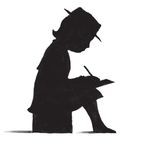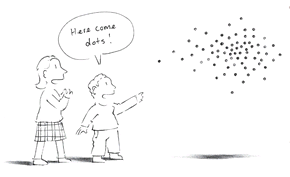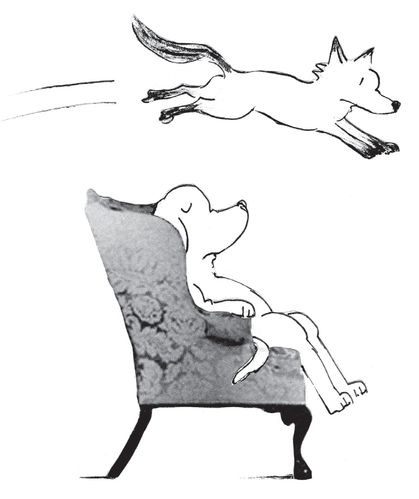The Word Snoop (8 page)
Authors: Ursula Dubosarsky

Dear Snoops,
I’m going to ask you all to close your eyes,
take a deep breath, and relax. (Hey, don’t go
to sleep!) Now think back to when you were
first learning to write your own name. How
important and mysterious the letters seemed,
each with its own special shape and sound.
take a deep breath, and relax. (Hey, don’t go
to sleep!) Now think back to when you were
first learning to write your own name. How
important and mysterious the letters seemed,
each with its own special shape and sound.
Ever since writing began, people have been
fascinated by the power of letters, and have
played around with them in all sorts of unusual
ways. Mixing them up, leaving them out, using
them all at once
—
there are so many things you
can do. The word for letter in ancient Greek
is “
gramma
,” and you’ll see that word over
and over again in this chapter with things like
anagram
,
pangram
and
lipogram
…
fascinated by the power of letters, and have
played around with them in all sorts of unusual
ways. Mixing them up, leaving them out, using
them all at once
—
there are so many things you
can do. The word for letter in ancient Greek
is “
gramma
,” and you’ll see that word over
and over again in this chapter with things like
anagram
,
pangram
and
lipogram
…
What-a-gram???!!!
Watch and wait, my dear snoops, and you’ll
soon find out…
soon find out…
Yours snoopfully,
Doors went hop
Doors went hop

4.
Letters, letters, letters
AnagramsH
ave a look at these pairs of words:
ave a look at these pairs of words:
LEMON/MELON
DANCE/CANED
ELVIS/LIVES
DANCE/CANED
ELVIS/LIVES
Look really hard at the letters. What do you notice about them? Well, in each pair, the two words are made up of exactly the same letters, they’ve just been arranged differently. This is called an anagram. The word comes from two ancient Greek words—
ana,
meaning “back” or “again,” and
gramma,
meaning “letter.” When you write the letters again in a different order, you get a whole new word.
ana,
meaning “back” or “again,” and
gramma,
meaning “letter.” When you write the letters again in a different order, you get a whole new word.
Anagrams are often found in puzzle books or crosswords. But ancient Greek philosophers, like Plato and Pythagoras, thought that anagrams were more than just for fun—they believed anagrams revealed hidden meanings in words.
Later, mathematicians and scientists like Galileo used anagrams as a code. They would put their discoveries into anagrams, so they could keep them a secret until they were ready to tell the world.
People have always enjoyed making anagrams out of their own names. An English mathematician, Augustus de Morgan, claimed to have made up about 800 anagrams from his name. King Louis XIII of France even had a Royal Anagrammatist, who would make anagrams of names on request. Twins sometimes have names that are anagrams of each other—like Tania and Anita, Claus and Lucas, or Ernie and Irene.
I wonder if you can make up an anagram of your own name? It doesn’t have to be another name, it can be other words. An anagram of The Word Snoop, for example . . . Aha! Look back at the letter I wrote you at the start of this chapter and see if you can work it out . . .
Writers love anagrams. Samuel Butler wrote a novel about an imaginary country called Erewhon—can you figure out where it is? And what about the land of Tribnia that the Irish writer Jonathan Swift invented in his book
Gulliver’s Travels
? And in Lemony Snicket’s
A Series of Unfortunate Events
, there’s a very unpleasant character called Count Olaf, and another one named Al Funcoot, and another one called Dr. Flacutono, and another, Dr. O. Lucafont, and an even more unsavory medical couple, Dr. Tocuna and Nurse Flo . . .
Gulliver’s Travels
? And in Lemony Snicket’s
A Series of Unfortunate Events
, there’s a very unpleasant character called Count Olaf, and another one named Al Funcoot, and another one called Dr. Flacutono, and another, Dr. O. Lucafont, and an even more unsavory medical couple, Dr. Tocuna and Nurse Flo . . .
Until recently, to work out an anagram you had to write all the letters down on a page in different orders, or use letter tiles and mix them up to find another word. It can be really hard to do. But now there are special computer programs that make up anagrams from any words you type in.
Still, it’s fun to do it the old-fashioned way. See if you can work out the anagrams on the following page—or better still, think up some for yourselves!

Anagrams
1.
Thorn, Shout, Seat, Stew (Hmm, which direction should we go?)
Thorn, Shout, Seat, Stew (Hmm, which direction should we go?)
2.
Listen (Where did all the noise go?)
Listen (Where did all the noise go?)
3.
Moon Starer (A student of the stars.)
Moon Starer (A student of the stars.)
4.
Here come dots (Great way to send a message.)
Here come dots (Great way to send a message.)
5.
The bear’s in (And he’s going to have a long, long nap . . . )
The bear’s in (And he’s going to have a long, long nap . . . )

There’s something special about the following sentence:
The five boxing wizards jump quickly.
Can you figure out what it is? Remember, it’s all about
letters
. . .
letters
. . .
Give up?
The answer is that it contains every letter of the alphabet—from A to Z. Have another look and check for yourself. Every single letter.
These kinds of sentences are called pangrams, which comes from two ancient Greek words—
pan,
meaning “all,” and
gramma,
which you might remember means “letter.” People have been writing pangrams for centuries, and not only with the English alphabet. There are pangrams in the Hebrew Bible, as well as in ancient Greek literature, such as Homer’s
Odyssey.
And there’s a pangram in Japanese that’s more than a thousand years old—a poem called the
Iroha
.
pan,
meaning “all,” and
gramma,
which you might remember means “letter.” People have been writing pangrams for centuries, and not only with the English alphabet. There are pangrams in the Hebrew Bible, as well as in ancient Greek literature, such as Homer’s
Odyssey.
And there’s a pangram in Japanese that’s more than a thousand years old—a poem called the
Iroha
.
Pangrams became most common after typewriters were invented in the late nineteenth century. This is because a pangram is a very quick way to make sure that all the keys on a keyboard are working. The most famous of all pangrams—
The quick brown fox jumps over a lazy dog
—was developed for this specific reason.
The quick brown fox jumps over a lazy dog
—was developed for this specific reason.

Pangrams are also a handy way of comparing all the letters in different fonts. Hmm, which do you prefer?

or

People are inventing new pangrams every day, just for the challenge. What’s called a “perfect” pangram is one that contains only 26 letters in total, but they’re very difficult to make up. Most pangrams contain many more letters than that.
A game you can play (and it’s easier than inventing a pangram itself) is to write a story where each word begins with a different letter of the alphabet in order. To give you an idea, on the next page is one that the Word Snoop just made up.
A b
lack
c
at
d
reamt
e
very
f
ourth
g
oose
h
unted
i
nvisible
j
ellyfish.
K
indly
l
et
m
any
n
ice
o
striches
p
ass
q
uickly.
R
ather
s
tupidly
t
he
u
mbrella
v
oted
w
hen
x
-raying
y
ellow
z
ebras.
lack
c
at
d
reamt
e
very
f
ourth
g
oose
h
unted
i
nvisible
j
ellyfish.
K
indly
l
et
m
any
n
ice
o
striches
p
ass
q
uickly.
R
ather
s
tupidly
t
he
u
mbrella
v
oted
w
hen
x
-raying
y
ellow
z
ebras.
Why not try to make up your own crazy pangrammatic story?
LipogramsI bet you’re wondering what a lipogram is. Um, a telegram with lips?
It might help to think of a pangram, which as we know is a sentence containing every letter of the alphabet. A lipogram is more or less the opposite of this. Instead of including
every
letter, you deliberately
leave out
a particular letter. The word comes from ancient Greek—
lipo,
meaning “lacking,” and
gramma,
meaning—you guessed it—“letter.”
every
letter, you deliberately
leave out
a particular letter. The word comes from ancient Greek—
lipo,
meaning “lacking,” and
gramma,
meaning—you guessed it—“letter.”
Writing lipograms goes right back to at least the sixth century BC, when a Greek poet deliberately wrote verses where none of the words contained the letter S. This is called a lipogram on S. The question is—why did he do this?
NOBODYKNOWS.
In the eighteenth century, the German poet Gottlob Burmann apparently wrote 130 poems without the letter R—lipograms on R. He was even said to have avoided using any words with the letter R in his everyday speech! Try that—oops, I mean, attempt that!
Okay, but why?
DON’T ASKME.
Of course, it’s easier to write a lipogram on a letter that is not very common, like Z or Q. It’s much much harder to write a lipogram on a letter like E, which is the most common letter in several languages, including English and French. Despite this, in 1939 Ernest Vincent Wright wrote a whole novel,
Gadsby,
without using a single E. He said that it was so difficult to write this book that he had to tie down the letter E on the keyboard of his typewriter to stop himself from using it. And following in his footsteps, in 1969 the French writer Georges Perec published a 300-page novel that also contained no E’s. It’s called
La Disparition,
which means “The Disappearance.” (Where did that E go?)
Gadsby,
without using a single E. He said that it was so difficult to write this book that he had to tie down the letter E on the keyboard of his typewriter to stop himself from using it. And following in his footsteps, in 1969 the French writer Georges Perec published a 300-page novel that also contained no E’s. It’s called
La Disparition,
which means “The Disappearance.” (Where did that E go?)
Other books
Seducing Mr. Heywood by Jo Manning
Night Sins by Lisa Renee Jones
Yesterday's Hero by Jonathan Wood
Pleasure's Edge by Eve Berlin
Long Lankin by Lindsey Barraclough
Chasing Chelsea by Maren Smith
Dead And Buried (Cooper and Fry) by Booth, Stephen
The Naked and the Dead by Norman Mailer
Equilibrium by Imogen Rose
Homestyle Japanese Cooking by Susie Donald
